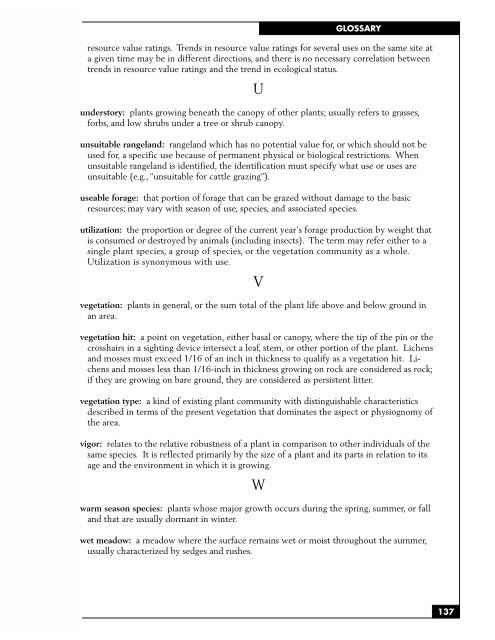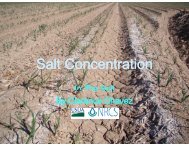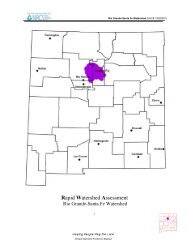SAMPLING VEGETATION ATTRIBUTES - New Mexico NRCS - US ...
SAMPLING VEGETATION ATTRIBUTES - New Mexico NRCS - US ...
SAMPLING VEGETATION ATTRIBUTES - New Mexico NRCS - US ...
Create successful ePaper yourself
Turn your PDF publications into a flip-book with our unique Google optimized e-Paper software.
GLOSSARY<br />
resource value ratings. Trends in resource value ratings for several uses on the same site at<br />
a given time may be in different directions, and there is no necessary correlation between<br />
trends in resource value ratings and the trend in ecological status.<br />
understory: plants growing beneath the canopy of other plants; usually refers to grasses,<br />
forbs, and low shrubs under a tree or shrub canopy.<br />
U<br />
unsuitable rangeland: rangeland which has no potential value for, or which should not be<br />
used for, a specific use because of permanent physical or biological restrictions. When<br />
unsuitable rangeland is identified, the identification must specify what use or uses are<br />
unsuitable (e.g., “unsuitable for cattle grazing”).<br />
useable forage: that portion of forage that can be grazed without damage to the basic<br />
resources; may vary with season of use, species, and associated species.<br />
utilization: the proportion or degree of the current year’s forage production by weight that<br />
is consumed or destroyed by animals (including insects). The term may refer either to a<br />
single plant species, a group of species, or the vegetation community as a whole.<br />
Utilization is synonymous with use.<br />
vegetation: plants in general, or the sum total of the plant life above and below ground in<br />
an area.<br />
V<br />
vegetation hit: a point on vegetation, either basal or canopy, where the tip of the pin or the<br />
crosshairs in a sighting device intersect a leaf, stem, or other portion of the plant. Lichens<br />
and mosses must exceed 1/16 of an inch in thickness to qualify as a vegetation hit. Lichens<br />
and mosses less than 1/16-inch in thickness growing on rock are considered as rock;<br />
if they are growing on bare ground, they are considered as persistent litter.<br />
vegetation type: a kind of existing plant community with distinguishable characteristics<br />
described in terms of the present vegetation that dominates the aspect or physiognomy of<br />
the area.<br />
vigor: relates to the relative robustness of a plant in comparison to other individuals of the<br />
same species. It is reflected primarily by the size of a plant and its parts in relation to its<br />
age and the environment in which it is growing.<br />
W<br />
warm season species: plants whose major growth occurs during the spring, summer, or fall<br />
and that are usually dormant in winter.<br />
wet meadow: a meadow where the surface remains wet or moist throughout the summer,<br />
usually characterized by sedges and rushes.<br />
137




